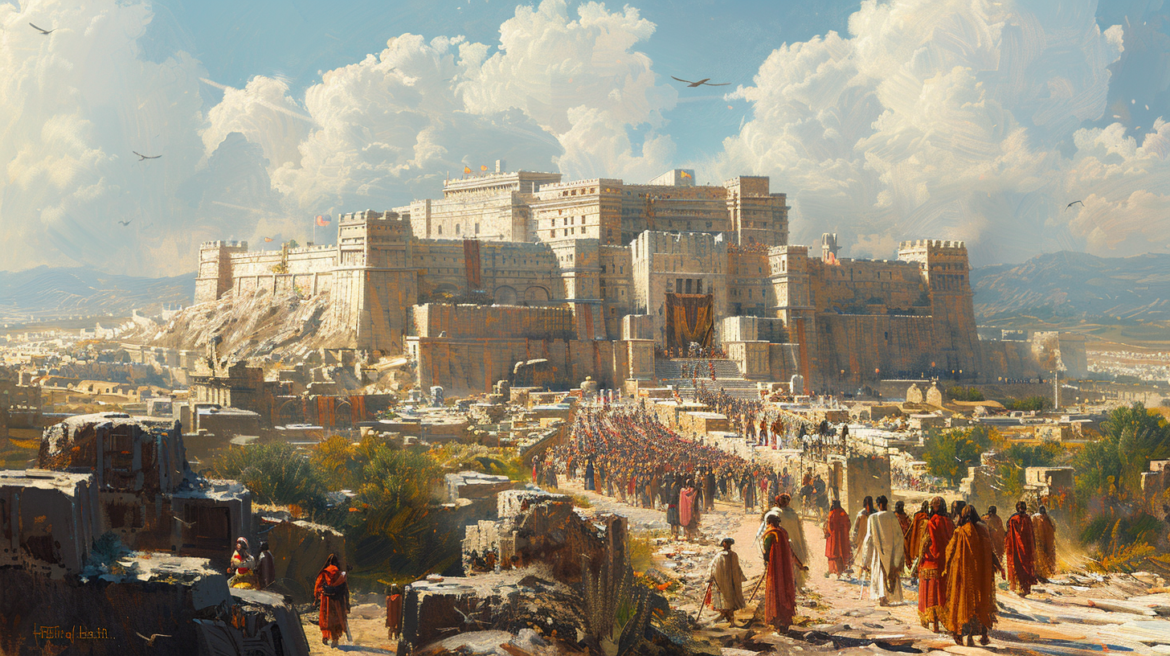The Hittite Empire, with its roots buried deep in the cradle of civilization, stands as one of the pivots on which the entire history of the Levant and Mesopotamia turns. From the misty past of Anatolia emerged a people hardened by its rugged terrains, forged by its iron deposits, and unified by a dream to carve a place in history. This is the story of the Hittites, a saga of ascendancy, innovation, and ultimate legacy.
Birth of the Hittite Empire
Steeped in antiquity, the tale of the Hittite Empire begins in a time unrecorded. The Hittite people were perhaps the very first inhabitants of central Anatolia. They were an industrious and enterprising people, learning to work with metals as soon as their neighbors, the Assyrians and the Egyptians. With time, they organized into a power structure that dwarfed their contemporaries.
The path to empire began with a single ruling line, an unbroken sequence of leaders bearing the mantle of kingship. These rulers, ensconced in the Hittite capital of Hattusa, started small, with ambitions likely no grander than the lands they could see. Yet, an incisive vision and an uncanny ability to unite disparate tribes into a singular Hittite identity were the crucibles that birthed an empire.
The Hittite emergence was marked by caution and shrewdness. They observed the fall of empires around them, noting the failures and celebrating the successes of their peers. Every defeat was a strategic retreat, every victory a lesson for the future. It was in this manner that the Hittite kings nurtured their young empire into robustness, gradually expanding their territories through alliances and territorial gains, all the while honing their military might for the grand challenges that lay ahead.
Ascendancy to Power
The Hittite ascent to power was not a single march of conquest, but a series of calculated moves slowly building their strength and reach. They were not just conquerors, but also statesmen who understood the delicate art of diplomacy. Their dealings with their neighbors, particularly the mighty kingdoms of Egypt and Assyria, are the stuff of legend as much can be learned.
The Hittite rulers masterfully navigated the patina of peace and the horror of war. They brokered treaties with sovereign rulers, formed familial alliances, and held sway over vassal states. Yet, they were also warlords without peer, forging their empire with the crucible of warfare. The echoes of their victories in the Battle of Kadesh and the defeat of the Mitanni still resound across the centuries, epitomizing the might of the Hittite chariots and steel.
This was an era in which empires were made through the sword and sanctified by the copper edge of diplomacy. The Hittite king-list is a testament to the might and the mandate of the rulers who, one by one, added laurels to the imperial diadem. They saw their influence stretch from the shores of the Aegean to the highlands of Syria, and their legacy cast a long shadow across the map of the ancient Near East.
Cultural and Technological Achievements
Embedded within the empire’s iron-forged boundaries was a culture rich with creativity and innovation. The Hittites were not merely a people of conquest; they were also pioneers who pushed the envelope of what it meant to be a civilization. Architecturally, they erected massive fortifications and soaring temples that spoke to their gods and the grandeur of their kings.
Their metallurgy was advanced for its time, with iron weapons that redrew the boundaries of warfare. The Hittites were renowned for their chariots, an innovation that raced across battlefields with an almost mechanical efficiency, laying waste to foes. And it was not just in the arts of war that the Hittites excelled; their craftsmen and engineers created works that stand witness to their ingenuity.
But perhaps their most enduring legacy lies in their laws and literature. The Hittites were a literate people, with a script that recorded their transactions and treaties. The legacy of their laws, known as the Hittite Code, endures as one of the earliest examples of codified legal systems. Their literature, both epic and prosaic, preserves their cultural memory, their triumphs, and their tragedies, ensuring a part of the Hittite soul persists through the ages.
The Decline and Legacy
The erosion of time and turmoil eventually chipped away at the Hittite Empire. The empire that had stood for centuries fractured in the crucible of change and challenge. The once mighty Hittite capital of Hattusa was lost to the mists of history, claimed by the confluence of environmental changes, civil strife, and the predations of migrating peoples. The Hittites faded from the stage of world powers, their name and glory ebbing into the pages of mystical remembrances and oral traditions.
Yet, the legacy of the Hittites is not one of mere decline, but of enduring impact. The lessons of their ascent and decline informed the strategies of empires that followed. The remnants of their fortresses and cities, reclaimed by nature, became the artifacts that inspired curiosity and awe in modern archeologists. The tales of their kings and queens continued to captivate the minds of scholars and storytellers.
For the Hittite Empire, the sun might have set, but the light it kindled still warms the tapestry of history. In the brazen heat of their chariots and the steadfast fortitude of their citadels, one can still detect the indomitable spirit that animated their empire. The Hittites, with their zeal for achievement and their tenacity in strife, carved more than just an empire; they etched their name into the very stone of existence. The land of the Hittites may have changed hands more times than it can recall, but it forever remains a testament to the people who once called it home, the Hittite Empire.
Deeper Reading:
“Warriors of Anatolia: A Concise History of the Hittites” by Trevor Bryce
